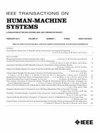Human–Robot Interaction Video Sequencing Task (HRIVST) for Robot's Behavior Legibility
IF 3.5
3区 计算机科学
Q2 COMPUTER SCIENCE, ARTIFICIAL INTELLIGENCE
引用次数: 0
Abstract
People's acceptance and trust in robots are a direct consequence of people's ability to infer and predict the robot's behavior. However, there is no clear consensus on how the legibility of a robot's behavior and explanations should be assessed. In this work, the construct of the Theory of Mind (i.e., the ability to attribute mental states to others) is taken into account and a computerized version of the theory of mind picture sequencing task is presented. Our tool, called the human–robot interaction (HRI) video sequencing task (HRIVST), evaluates the legibility of a robot's behavior toward humans by asking them to order short videos to form a logical sequence of the robot's actions. To validate the proposed metrics, we recruited a sample of 86 healthy subjects. Results showed that the HRIVST has good psychometric properties and is a valuable tool for assessing the legibility of robot behaviors. We also evaluated the effects of symbolic explanations, the presence of a person during the interaction, and the humanoid appearance. Results showed that the interaction condition had no effect on the legibility of the robot's behavior. In contrast, the combination of humanoid robots and explanations seems to result in a better performance of the task.人机交互视频排序任务(HRIVST)促进机器人行为的可识别性
人们对机器人的接受和信任是人们推断和预测机器人行为能力的直接结果。然而,对于如何评估机器人行为和解释的易读性,目前还没有明确的共识。在这项工作中,考虑到心理理论的构建(即将心理状态归因于他人的能力),并提出了心理理论图像排序任务的计算机版本。我们的工具,称为人机交互(HRI)视频排序任务(HRIVST),通过要求他们订购短视频来形成机器人动作的逻辑顺序,来评估机器人对人类行为的易读性。为了验证所提出的指标,我们招募了86名健康受试者的样本。结果表明,HRIVST具有良好的心理测量性能,是评估机器人行为易读性的一种有价值的工具。我们还评估了象征性解释、互动过程中人的存在以及人形外观的影响。结果表明,交互条件对机器人行为的易读性没有影响。相比之下,类人机器人和解释的结合似乎能更好地完成任务。
本文章由计算机程序翻译,如有差异,请以英文原文为准。
求助全文
约1分钟内获得全文
求助全文
来源期刊

IEEE Transactions on Human-Machine Systems
COMPUTER SCIENCE, ARTIFICIAL INTELLIGENCE-COMPUTER SCIENCE, CYBERNETICS
CiteScore
7.10
自引率
11.10%
发文量
136
期刊介绍:
The scope of the IEEE Transactions on Human-Machine Systems includes the fields of human machine systems. It covers human systems and human organizational interactions including cognitive ergonomics, system test and evaluation, and human information processing concerns in systems and organizations.
 求助内容:
求助内容: 应助结果提醒方式:
应助结果提醒方式:


